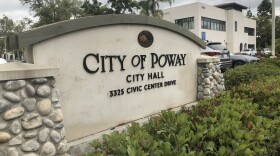A smart grid uses digital technology to save energy, reduce costs and increase reliability. Utilities across the nation are researching ways to transform the existing power grid and this has led to an emerging market for technologies that can help power companies make the transition.
It was a busy scene at Distributech, the utility industry’s largest smart grid conference, held at the Convention Center in San Diego earlier this month. The event was attended by nearly 8,500 people who visited the stalls of 400 exhibitors from around the world.
On display were a range of technologies to transform our electrical grid into a smart grid.
On Ramp Wireless was one of several San Diego firms there. It has received a Department of Energy grant to develop a wireless system that quickly alerts the utility when power lines go out.
“Fifty to 60 percent of the power grid is below ground. Without wireless technology that can connect below ground, you do not have a smart grid,” he said.
Silva explained that the wireless system enables the sensors embedded under ground to transmit signs of problems promptly.
“Today, it’s the customer who must call the utility to restore power. It can take three to four hours to locate a fault. With wireless sensors, we can reduce the time to minutes,” Silva said.
The arrival of electric vehicles (EV) has presented opportunities and issues for utilities.
Several companies focus on helping them cope with the increased load from charging stations.
Logica, a U.K company whose U.S base is in Houston, has developed an information system to help utilities track when and where EV owners charge their cars.
“It would create a significant spike in energy usage if everybody came home and plugged their vehicles in at the same time," Logica’s Senior Vice President Jeremy Schutte explained. "That spike would require the utility to have to build out a lot of transmission and distribution infrastructure.
"By managing that load, we can help the utility defer or eliminate the need to make that expenditure.”
Logica can also help utilities figure out how much to charge the EV owners.
“The utility provider wants to track the usage patterns and wants to bill the electric-vehicle owners for the right amount of electricity that they've consumed. Our system allows them to do both of those things,” said Nigel Spooner, Logica’s U.K based director.
Information-technology service providers like Logica are gearing up to help power companies even out the load, by encouraging EV owners to charge during off-peak hours.
Variable pricing strategies, which utilities like San Diego Gas & Electric are still working on today, will motivate car owners to charge when it is cheaper, like at night, thereby spreading energy usage.
“We really help utilities envision how the future is going to look, when the equivalent of tens of thousands, or hundreds of thousands of tea kettles are plugged into the grid at the same time,” Schutte said.
Both On Ramp and Logica are still talking to utilities in the U.S. But Logica’s solutions are being used in the Netherlands and Schutte said U.S power companies could take a leaf out of that book.
“One lesson I think California can take away from what we’ve seen in Europe is that for EV charging to become a reality, cities and towns and utilities have to come together and collaborate. So when the utilities are ready to work together, we’re ready to help them,” Schutte pointed out.
Schutte, like others at the smart-grid event, said U.S utilities have shown a lot of interest. But it will be a while before such technology becomes reality.





